Mostly famous for its paradisiac beaches like Alter do Chão and the Marajó Island, the state of Pará is a place filled with interesting destinations to visit. Amongst one of them is the state’s capital, Belém.
Amongst the many things you can do in Belém (Brazil), there are paradisiac beaches to visit, local delicacies like açaí, artisanal chocolate and jambu cachaça to try, and a lot of nature-related tourism, allowing you even to get a small taste of the Amazon Rain Forest.
In this post, we’re going full-in on everything you need to know about Belém do Pará’s main tourist sites. We’re talking best time to visit, the average temperature in the city, all the main activities and places you must visit, and other important information you should know.
Note: all of the values displayed in this article were based on the American dollar quotation of the day this post was written (USD 1.00 – BRL 5,71), so you may find discrepancies depending on the exchange rate of the day you do your own research.
When Is Best Time To Visit Belém in Brazil?
To answer that question, we first need to go over how the seasons work in Brazil. Most states in the country have their Summers beginning in December, extending through February. The year cycle ends with Spring, which starts in September and ends in December.
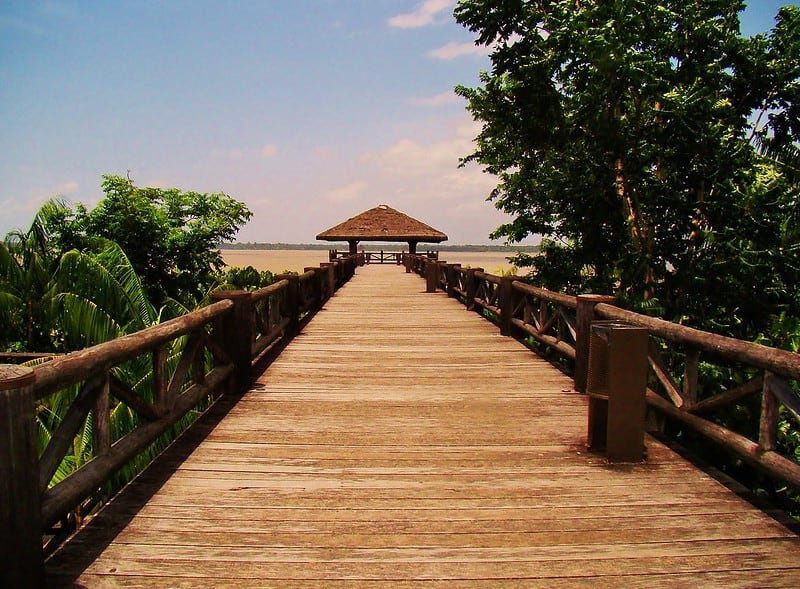
Due to its geographic position in regards to the tropics (and its closeness to the Amazon Rain Forest), the north region of Brazil experiences the weather differently, with all three seasons (except for Winter) almost blending into one, given the few differences caused by the change of seasons.
Because of that, Summer is considered to start in June and extend all the way through late November, when the rainy season begins. Despite that, you can visit Belém any time of the year, as you’ll mostly find good weather in all 12 months of the year.
Summer in Belém | June – November
Summertime (drought period) is obviously the city’s high season, given the perfect weather with few chances of raining. Like most tropical destinations, the intense heat during the day causes high possibilities of storms in the late afternoon. Still, those are generally quick and dissipate in a matter of minutes.
If you happen to be traveling to Belém in October, you’ll probably find the city busier than usual. The 12th of October marks the Círio de Nazaré, a catholic celebration that completely changes the city’s logistics.
Now, if you’re looking for some peace and quiet during your trip to Belém, stay clear from this date, as the city gets very crowded. The Círio de Nazaré celebration is indeed beautiful, but if you’re not in the mood to face big crowds, I would suggest you try to find a different date to come to Belém.
Winter In Belém | December – April
Although Wintertime means chilly weather (or at least lower temperatures) in most places, it’s still warm in Belém, believe it or not. The rains are indeed very present during this season, which causes the temperature to drop, but not to the point when it’s not hot!
If you’re on a shoestring budget or just wants to avoid the high season’s elevated accommodation and leisure prices, it’s not such a bad idea to come to Belém during the winter, but keep in mind that you’ll most likely be facing a lot of rain during your trip.
What Is The Average Temperature In Belém (Brazil)?
Throughout most of the year, the climate is hot and humid. The average temperature revolves around 24 °C to 32 °C (75 °F to 90 °F) and rarely gets under 23 °C (73 °F) or over 33 °C. (91 °F).
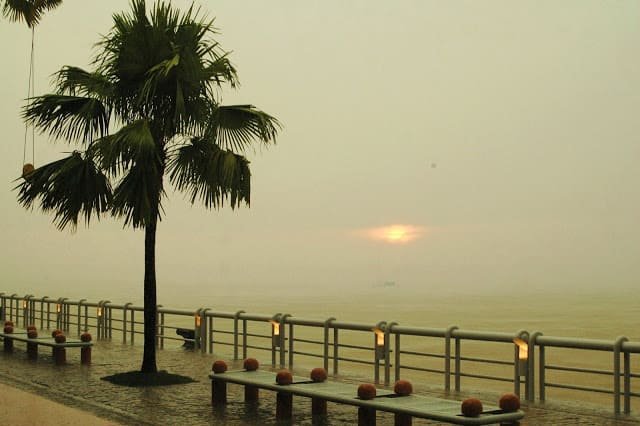
As we said before, one of the reasons for the little thermal amplitude in the north region of Brazil is the proximity to the Amazon Rain Forest. Still, the area’s closeness to the Equator Line is also one of the key factors in why the temperature variation is minimal throughout the year.
Here’s the average temperature in Belém month by month:
| JAN | FEB | MAR | APR | MAY | JUN | JUL | AUG | SEP | OCT | NOV | DEC | |
| Average MAX temperature | 30,9°C / 87,6 °F | 30,5°C / 86,9 °F | 30,4°C / 86,7 °F | 30,8°C / 87,4 °F | 31,3°C / 88,3 °F | 31,7°C / 89 °F | 31,7°C / 89 °F | 32,1°C / 89,7 °F | 32,1°C / 89,7 °F | 32,2°C / 89,9 °F | 32,3°C / 90 °F | 31,9°C / 89,4 °F |
| Average MIN temperature | 22,1°C / 71,7 °F | 22,2°C / 71,9 °F | 22,4°C / 72,3 °F | 21,8°C / 71,2 °F | 22,6°C / 72,6 °F | 22,1°C / 71,7 °F | 21,7°C / 71 °F | 21,7°C / 71 °F | 21,7°C / 71 °F | 21,6°C / 70,8 °F | 21,9°C / 71,4 °F | 22°C / 71,6 °F |
As you can see, the temperature is pretty consistent throughout the year, so you don’t really need to worry about that. The only thing you need to worry about if you’re planning on coming is the rainy season, especially if you’re looking to explore the local beaches.
What Should I Pack If I’m Going to Belém in Brazil?
Given all the switch-ups regarding seasons and temperatures, it may seem a little confusing or challenging to consider what you should bring on your trip. With that in mind, here are some tips on what you should be packing to Belém:
- Swimming Suits & Bikinis
With many beaches and natural sites to visit, packing your swimwear is almost the most important thing you can have in your suitcase, as a lot of the tourism revolves around the paradisiac beaches. You can also shop for new pieces at the local stores, which specialize in these products. - Light Clothing
Even during wintertime, you probably won’t be needing any coats or sweaters. Even if the temperature drops in Belém, the humidity is elevated throughout most of the year, keeping the thermal sensation warm and hot. Pack your t-shirts, tank tops, and short shorts; you’ll be wearing these a lot. - Sunscreen & Bug Repellent
These aren’t necessarily things you need to pack from home, as you can get those in Brazil once you’ve arrived, but it’s nice putting them on the list so you won’t forget about them.
Sunscreen is obviously a must-have, given the Sun’s intensity. The bug repellent is handy since the city’s hot weather and closeness to the water attract many mosquitoes. - Comfortable Footwear
You’ll be doing a lot of tourism on foot, so you need to think about comfort before style. Choose a pair of shoes with which you’re able to travel long distances, and of course, don’t forget to buy yourself a pair of Havaianas once you’ve arrived.
What Is The Best Way To Go To Belém in Brazil?
If you’re thinking about visiting, the best way to travel to Belém (in Brazil) is by plane. Whether you’re coming from inside or outside Brazil, flying to Belém is the most convenient way to get there, especially if you manage to buy plane tickets for a reasonable price.
If you’re coming from outside Brazil, these are the airline companies that usually make flights to Belém:
- LATAM
- American Airlines
- TAP Air Portugal
- Surinam Airways
- United
- Delta
But if you’re already in Brazil and plans on paying the north region of Brazil a visit, these are the national airline companies to look for:
- Gol
- Avianca Brasil
- Azul
Can I go to Belém by Travel Bus?
Yes, depending on where you’re leaving from, it’s a good idea to look into taking a travel bus to Belém. Airplane tickets can be pricy in Brazil (especially for domestic flights), so if the distance is reasonable, and you’re looking to save a little cash, maybe taking the bus isn’t such a bad idea.
If you have a valid driver’s license and a good sense of direction (aka GPS), you can also rent a car and drive to Belém. Just don’t forget to consider if it’s really worth spending hours on the road instead of just flying to Belém and arriving fresh.
What Are The Main Airports in Belém, Brazil?
The city of Belém only has one airport, the Júlio Cezar Ribeiro International Airport (BEL). It is located just over 7 miles (12km) from the city’s downtown, making it pretty convenient to access.
Still, even though pretty close, the city of Belém still has a long way to go about public transportation facilitating access to the general population to the airport, so the best way to/from the location is by Uber or yellow cab.
Can I Get to Belém (Brazil) By Boat?
Yes, you can get to Belém by Boat. The city’s harbor (Porto de Belém) is located in the Reduto district, and shelters over 10 warehouses and a touristic complex called Estação das Docas, in which you can also find the Belém Harbor Museum.
Many cruise ships harbor at Porto de Belém throughout the year, making it possible to visit the city while you’re cruising around the Atlantic.
How Many Days Should I Spend in Belém (Brazil)?
If you want to thoroughly enjoy everything Belém has to offer, you can fit the major activities and tours in a 4-day itinerary. Most points of interest and tourist sites aren’t further than 3 miles (5km) from the city’s downtown, which could save you some time while moving from one place to another.
What Is The Best Way To Move Around in Belém (Brazil)?
Considering the city’s poor public transportation system, the best way to move around in Belém would be either by Uber or renting your own car.
I would strongly recommend the latter if you’re planning on getting to know all (or at least most) of the beaches in Belém. Not only having a car will get you there faster and more comfortably, but it will also facilitate access to more distant shores and coasts.
Things To Do In Belém (Brazil)
Now, let’s get to the interesting stuff: the tours and things to can do while in Belém. There’s a lot to do around in the city, so I would highly advise you to organize your trip with a little schedule with your major points of interest listed. Here are a few ideas of things you can do in Belém:
Visit the Combu Island (Ilha de Combu)
If you want to get a small taste of what the Amazon Rainforest feels like, take the boat from the south of the city and head down to Ilha do Combu, a beautiful natural tropical forest which locals refer to as the land of cacao and açaí (which I absolutely love).
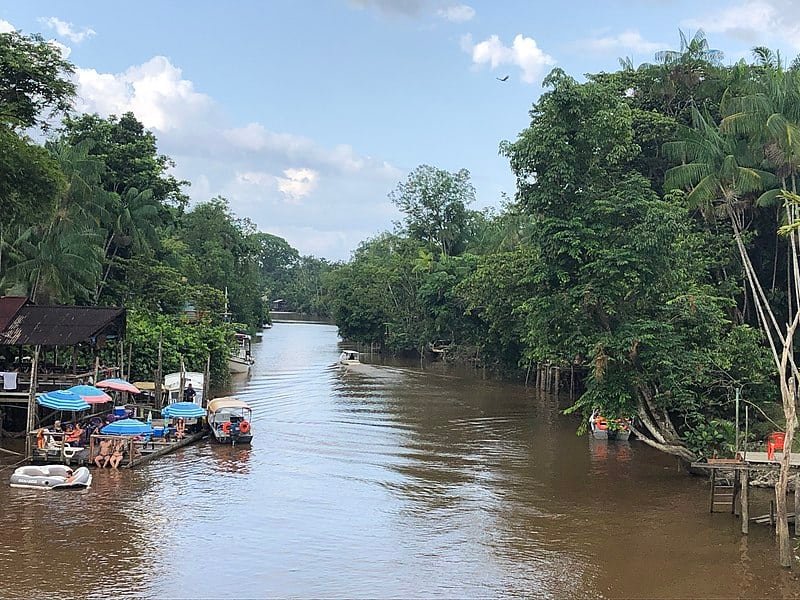
While on the island, you can sail through the forests shallow water streams, go trekking in the middle of the nature’s wild, and even taste 100% natural chocolate. Just ask the boat driver to take you to Dona Nena, which is a local chocolate factory that uses the island’s cacao as the main ingredient.
Speaking of good food, some Combu island’s restaurants are masters in uniting enjoying the nature and delicious local dishes. Restaurants like Saldosa Maloca and Chalé da Ilha feature natural pools and even zip lines, not to mention the island’s main course, fried Tambaqui, which is a local type of fish in the region.
Where: take the boat at Praça Princesa Isabel in the Condor district
How Much: BRL 7,00 – USD 1.22 per person
Visit The Local Beaches in Belém
Pará is pretty known for its beautiful beaches, and some of them can be found in Belém. There are three main beaches you can visit in Belém:
Vai Quem Quer Beach
This beach is located at the Cotijuba island, which is 45 minutes away from Belém. Its name loosely translates into something in the lines of “you go if you want to”, a humorous name given to the Vai Quem Quer beach because of the distance and difficult access from the harbor to the beach’s shores.
Most adventurous explorers choose to make the trip on foot, which takes around 25 minutes (9km – 5,5 miles). If you’re up to the task, it can be a pretty good exercise before you hit the water as a reward.
But, if you want to save some energy for later, there are taxi-motorbikes, chariots, and even a transportation service called “bondinho,” which are basically vehicles pulled by small tractors that carry visitors from the island’s harbor to the Vai-Quem-Quer Beach.
The island can be accessed through the Icoaraci district wharf, where many boats set sail to Cotijuba. You can also take a boat from Praça do Pescador, and the total travel time to get to the shores is around 45 minutes.
The Vai Quem Quer Beach is the most famous beach in Cotijuba island, which may seem inconsistent given the lack of people visiting, but understandable if you take into consideration the effort it takes to get there.
Either way, if you’re looking for a more tranquil environment and less crowded beach, Vai Quem Quer Beach is your best bet. It has a nice (but simple) infrastructure, with a few rustic inns, bars, and restaurants.
Where: take the boat at the Icoaraci Harbor
How Much: BRL 5,00 – USD 0.87 per person
The beaches at Mosqueiro Island (Ilha do Amor)
Referred to by locals as Ilha do Amor (Love Island), the Mosqueiro Island is located approximately 43 miles (70km) from Belém and has over 15 beaches along its coast’s 132 miles.
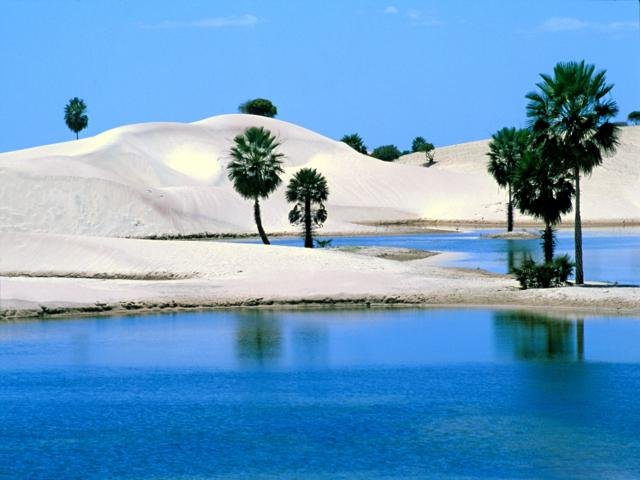
Unlike the previous island, getting to Ilha do Mosqueiro doesn’t require a boat, as the Sebastião Oliveira bridge connects the island and the São Braz district. It takes around an hour by car and 2 hours if you take the travel bus.
The Beira-Mar Avenue (which faces the Mosqueiro shores) is filled with bars, restaurants, and inns, as well as sumptuous manners along the coast. The house’s architectures are really charming, notoriously known in the past as the summer houses of the rich.
Most of these mansions were built in the 19th century when Belém was going through major economic growth due to the rubber boom in the Amazonic region, so the local wealthy families were able to upscale their game.
Praia Grande
Praia Grande is located at Caratateua Island, 15 miles (25km) away from downtown Belém. Being much closer than the other beaches, Praia Grande is the main point of interest of several tourists, being a much affordable and accessible beach destination in the city.
This is clearly reflected in the beaches’ commerce and infrastructure, which is far more intense and varied compared to the previous locations. You find a much wider assortment of vendors and products, like the local delicacy camarão seco (dry shrimp).
On the downside, this contributes to the poor state in which the sands at Praia Grande can be found sometimes. Many people have complained on Trip Advisor regarding the amount of trash and waste left behind at the beach caused by rude guests.
To access the Praia Grande beach, you can take a bus at Praça do Operário (right in front of the Belém Bus Station), and the total trip will take about 20 minutes to get from one point to the other.
Visit Mercado Ver O Peso
They say that if you want to really want to know more about a city’s habits and culture, one of the mandatory places to visit are the local markets and stores.
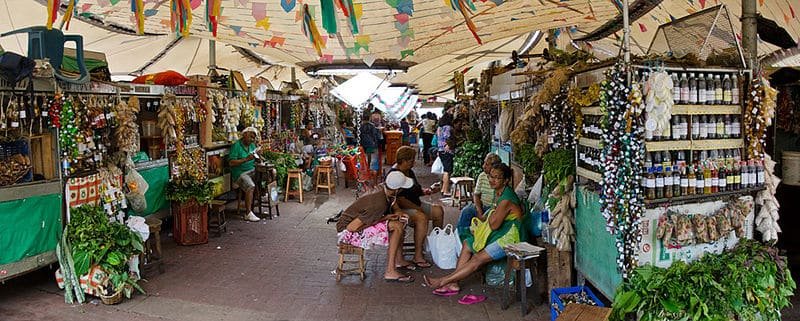
In Belém, this is the case with Mercado Ver O Peso, located at the docks of Guarajá Bay. Considered one of the largest open markets in Latin America, you’ll find everything from fish, to meat cuts, fresh produce, vegetables, spices, sauces, herbs, and even antiques and furniture.
The market complex area houses an incredible 367 ft² in total so that you could be spending hours just browsing and sampling products in the different tents and vendors. Some of the stuff is so good you could even bring it home as souvenirs; I mean, who doesn’t love getting food as a gift? (I know I do)
If you’re interested in visiting Belém’s Ver O Peso market, I suggest you go in the morning, as everything is fresher and the market’s a little emptier. Going there at lunchtime is also a great idea, as there are several restaurants to choose from.
Where: Castilhos França Boulevard at the Campina district
How Much: free entrance
Visit The Estação das Docas Market Complex
If you’re looking for a more upscale version of the Ver O Peso Market, Belém also has one of those! Originally built in the 19th century, the Estação das Docas market has been recently restored and completely renovated, serving today as the town’s gastronomic area.
This complex is another part of the main touristic tour of places to visit around in Belém, and the market usually received a lot of people looking to have a meal at one of its restaurants. There are tons of options to chose from; it’s just a matter of how much you’re willing to spend or what you are in the mood for.
The Estação das Docas market also has a huge veranda, in which you can watch the sunsets while having a drink. The local bars are also a good place to go if you’re looking to have a few cocktails before heading for a night out.
Where: Castilhos França Boulevard at the Campina district
How Much: free entrance
Visit the Mangal das Garças (Heron Mangrove)
Image visiting a place in which you can, all at once, have access to cinematic landscape, to a butterfly center (where several species are taken care of), artificial lakes, restaurants, and even a museum. Mangal das Garças is that place in Belém and definitely worth stopping by on your visit to the city.
Amongst the places you can visit, there’s the Belém Lighthouse, in which you’ll get a beautiful panoramic view of the whole town; and the Memorial Amazônico de Navegação, which is a place you can learn more about the evolution of sea transportation.
The butterfly center, which we previously referenced, is a beautiful place, almost fairy-tale-like. There are over 5k butterflies born every month in the center, serving as a safe place for the preservation of several species.
If you’re visiting during the Summer, don’t forget to visit Mangal’s artificial lakes, Carvename and Ponta. Aside from keeping you fresh during the heat, you’ll also be able to observe the animal life of Belém, witnessing how many wading bird species coexist in the place.
To recover your energy from all of that, head to Manjar das Garças, the local restaurant. They serve excellent seafood dishes, as well as typical Brazilian food.
Where: Carneiro da Rocha street at the Cidade Velha district
How Much: free entrance
Visit And/Or Watch A Performance At Theatro da Paz
Theatro da Paz is probably Belém’s biggest visual representation of how the rubber boom in the region in the late 19th century made the local economy more prosperous and successful.
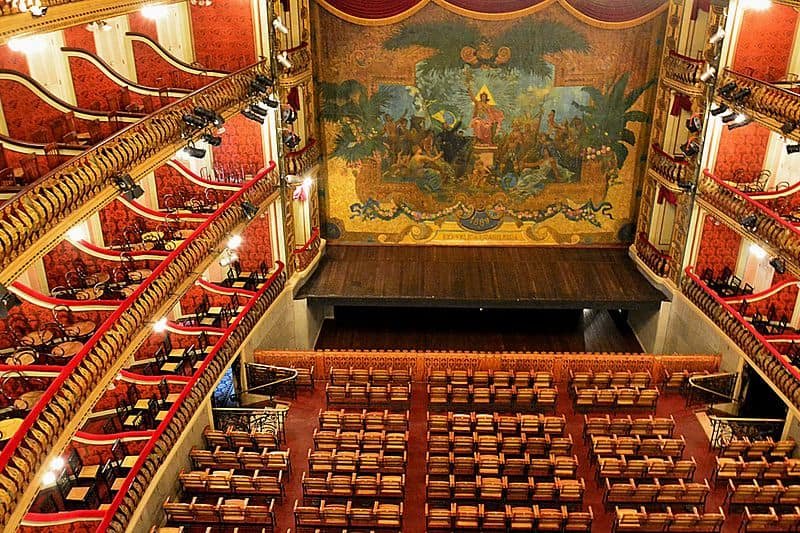
Just as a quick history recap, the north o Brazil had a pivotal importance in exporting rubber to the US and Europe, which both needed the material to continue the industrialization and manufacturing of machinery like cars, a valued commodity at the time.
As the outcome of being in the center of such economic growth, many European families started to head to Belém, slowly making an impact on the city’s architecture and looks. Theatro da Paz is one of the most obvious examples of that upgrade.
The placed with filled with beautiful chandeliers, minimally detailed frescoes, marble floors and every other type of thing you can think of regarding a display of wealth in the early 1910’s.
You can visit the theater for just a tour (which happens every day), but if you’re lucky, you may also be able to catch some kind of performance at Theatro da Paz, as many concerts and operas are still held on the main stage.
Where: Presidente Vargas Avenue at the Praça da República
How Much: BRL 6,00 – USD 1.05 per person (admission-free entrances on Wednesdays)
Have Cachaça shots at Boteco Meu Garoto (Meu Garoto Bar)
There’s a traditional local alcoholic beverage in Brazil called cachaça, which I’m pretty sure you must have heard of if you know a little bit about Brazilian culture. Cachaça is the main ingredient for Brazil’s own world-famous caipirinha, probably the country’s most well-known drink.
In Pará, they have a special type of caipirinha made with jambu, a local herb famous for its tingly and numbing effects. In Belém, if you head to Meu Garoto Bar, you’ll be able to taste the original cachaça de jambu, as the bar’s owner, Leo Porto, claims to have invented the variation.
The place is an excellent choice for a night out, especially for the ones who love to try out different things. There are many different types of infused cachaças, as well as other drinks to choose from. Plus, the bar’s decoration is pretty charming, with the typical Brazil-boteco motif but updated in a “cooler” version.
Where: Sen. Manoel Barata street at the Campina district
How Much: free entrance
Visit the Local Museums
Casa das Onze Janelas
Located right in front of the Presépio Fort, Casa das Onze Janelas’ beautiful colonial architecture currently houses a big contemporary art collection, being an insteresting choice for the art lovers as well as those just looking to marvel at the beautiful architecture.
Even if you’re not interested in touring inside the museum, visiting the place’s patio is a great way to spend time at a beautiful place, especially having a river right in front of you. That’s associated with the beautiful green garden is guaranteed to make it feel like time has stopped.
Where: Siqueira Mendes street at the Campinas district
How Much: BRL 4.00 – USD 0.70 (admission-free entrances on Tuesdays)
Museu Emílio Goeldi
If Mangal das Garças wasn’t able to quench your thirst in regards to the animals and wildlife in Belém, the Emilio Goeldi museum should probably do the trick. Located in the Nazaré district of Belém, the museum is also a research institution and a zoo for rescued animals.
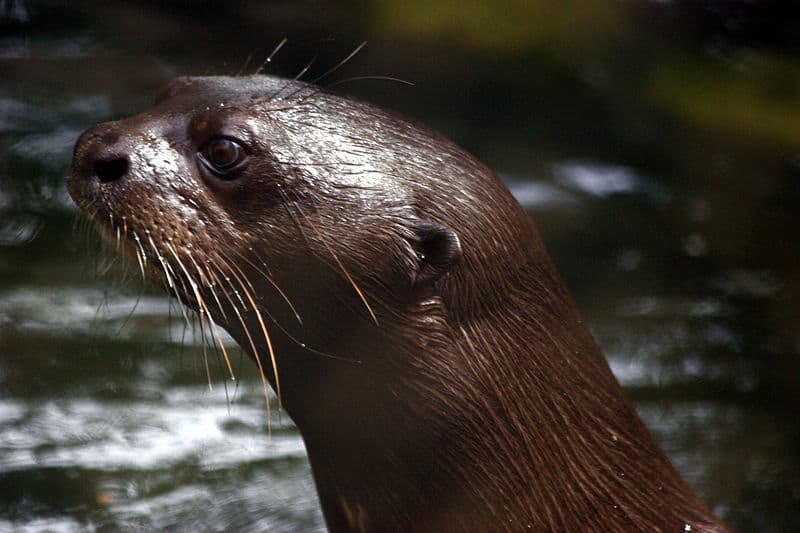
Founded in 1866, the Emilio Goeldi museum has 3 main complexes: the Zoobotanical Park, where animals there were rescued either from deforestation or illegal trafficking are cared for by vets and specialists, You’ll be able to see endangered species such as jaguars, araras, anteaters and manatees.
There are over 600 animals and 2k native trees, making this a great tourism spot in Belém. The Emilio Goeldi museum also has a big aquarium with an Amazonian aquatic environment with several fish species.
The other 2 complexes are for research purposes, both of them having excellent infrastructure for the development of studies and investigations regarding the tropical forest environment.
Where: Gov Magalhães Barata Avenue, number 376 at the São Brás district
How Much: BRL 3.00 – USD 0.52
Museu do Encontro
The Encontro Museum is located inside the Presépio Fort (our next topic), in a special section named Guaimiaba, which serves as a display of the Amazonic culture from the native Indian tribes that resided in the region.
You’ll be able to see pottery and ceramics from the marajoara and tapajó cultures, as well as fragments of historical pieces and a lot of relics obtained from the very same grounds the museum stands today.
Unfortunately, you can’t take pictures of the pieces inside Museu do Encontro. After the Covid-19 started in 2020, the Museum closed its doors for maintenance, so make sure it’s open again before you visit.
Where: Praça Dom Frei Caetano Brandão, Cidade Velha district
How Much: BRL 4,00 / USD 0.70 included in the Presépio Fort tour)
Visit the Presépio Fort (Forte do Presépio)
Built at the beginning of the 17th century, the Presépio Fort was used as an observation station against native Indian attacks and invasions by land and water (through the Guajará Bay). The Fort’s walls would only be brought up in the middle of the 19th century, separating it from the local citizens and residents.
The Presépio Fort has been through several remodelings ever since it was constructed, acting today as a cultural and archeological site. It comprehends a lot of the history of the city of Belém and the history of the residents who lived in the region before the colonization period.
Walking through the Fort is a beautiful experience, especially given how well-treated the area is. There are archaeological remnants of the old buildings in an area called Sítio Histórico da Fundação da Cidade, as well as a section dedicated to the Amazonic culture.
From the top of the fort’s walls, you can get a look at the whole Belém historic center, as well as the Ver O Peso Market. As a matter of fact, the Presépio Fort is part of the main touristic tour around Belém, so don’t miss out if you want to make sure you visit all the historical sites.
Where: Praça Dom Frei Caetano Brandão, Cidade Velha district
How Much: BRL 4,00 / USD 0.70 (includes the Encontro Museum entrance fee)
Enjoy The Culinary of the North of Brazil
Pará and the whole north of Brazil are very culturally rich, with the typical food and dishes being major representatives of that culture. The main ingredients generally used in the courses are corn, cassava, powdered guaraná, açaí, cupuaçú, chestnuts and different types of fish.
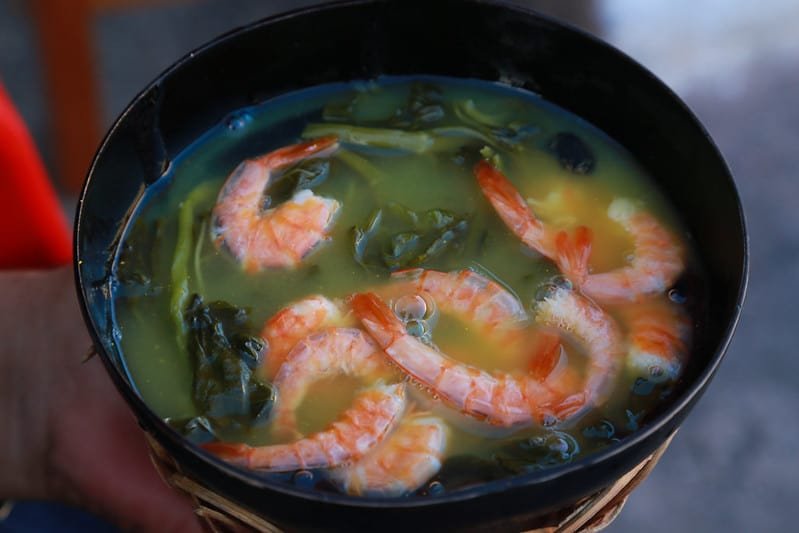
MTur Destinos
Here are a few suggestion on where to eat in Belém, Brazil:
- Iacitatá: a restaurant and a true food culture center, Iacitatá is run by local producers, who grow all the ingredients (no pesticides) and prepare all the meals. The chefs are truly passionate about their food, which reflects on how delicious they all taste. The good thing is, the prices are pretty modest and accessible.
- Remanso do Bosque: owned by brothers Thiago and Felipe Castanho (the latter is a famous chef in Brazil), the Remanso do Bosque restaurant offers the most typical food in their original recipes as a few sophisticated remixes of the same.
- Tacacá do Renato: tacacá is a very traditional dish from the north of Brazil with dry shrimp and dry cassava starch as the main ingredients. The tacacá made in this restaurant is pretty famous in the region, and they even make their own tucupi (the dressing that goes with the dish)
- Lá em Casa: one of the main attractions at the Estação das Docas restaurant complex, the highlight here are the sampling portions. You can order mini versions of many traditional dishes so you can (literally) have a little taste before you make your final order. Lá Em Casa is located inside the Estação das Docas complex and makes it a little more expensive than other places, but nothing too major.
- Govinda Vegetariano: Thinking about the vegetarians and vegans who want to try the local food, Govinda Vegetariano specializes in putting a green-friendly spin on most typical dishes. Even if you’re not a vegan, it’s still worth eating here; the food is really, really good.
- Amazon Beer: Amazon Beer is the biggest artisanal beer producer in town, having over 10 types in its catalog. The main difference from other artisanal beer brands is that Amazon Beer uses local raw material in its composition, like traditional fruits and herbs found in the region.
Visit the local cathedrals and basilicas
As we briefly mentioned at the beginning of our article, the Cílio de Nazaré is an important Catholic celebration that happens every year in Belém on the 8th of October.
This involves 2 of the main churches in the city, them being the Belém Metropolitan Cathedral (Catedral Metropolitana de Belém) and the Nossa Senhora de Nazaré Basilica, which are both the start and end locations for the religious cortege.
Belém Metropolitan Cathedral
If you’re visiting the Casa Das 11 Janelas Museum, you have to stop by at the city’s Metropolitan Cathedral, which is just across the street. The cathedral isn’t as sumptuous as the basilica we’re about to see, but it is where the Cílio de Nazaré cortege starts after a celebratory mass for Nossa Senhora de Nazaré, a local saint.
After the mass is done, the people carry a statue of Nossa Senhora de Nazaré (that was found near the church in the 1700s) from the cathedral to the Nossa Senhora de Nazaré Basilica, which is about 3 miles away. The cortege usually lasts around 15 minutes, and it is greatly supported by the locals.
Nossa Senhora de Nazaré Basilica
Located pretty close to Theatro da Paz, the Nossa Senhora de Nazaré Basilica is one of the most beautiful and important churches in Belém, Brazil. Even if you’re not a Catholic (or religious for that matter), it’s definitely a good idea to check the basilica’s architecture and grandeur.
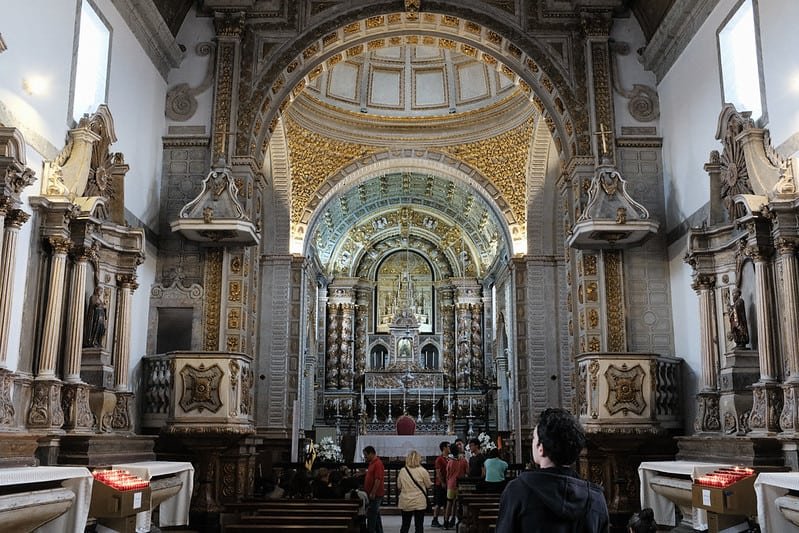
Fred Inklaar
The place almost feels like a museum, given the details in the beautiful stained glass arts, sacred works of art, and the massive organ that composes the basilica’s lavish looks.
Have a Traditional Açaí at Feira do Açaí
Açaí is probably one of my favorite things out of all the tipical dishes in the north of Brazil. If you have never tried it, this is the perfect ocasion: the açaí is a typical fruit of this region, very rich in healthy fatty acids and antioxidants.
The original traditional açaí is made with the fruit’s frozen pulp, resulting in a thick refreshing smoothie, perfect for the hot days in Belém. If you happen to go to Mercado Ver o Peso, there’s a small open market in its vicinity, in which vendors specialize in açaí. Whether you eat it on the spot or decide to take some home, make sure you try it!
Short Trips You Can Make From Belém
If you’re going to Belém, maybe reserving a day or two to make short trips to the close-by locations could be a good idea, mainly since there are so many picturesque spots near the city. Here are a few suggestions on what you can do near Belém:
Marajó Island
Located 56 miles (90km) away from Belém, the Marajó Island can only be accessed by boat or plane, but it’s well worth the effort. The island is famous for a natural phenomenon called pororoca, which is when giant waves are formed caused by the meeting of river and ocean waters.
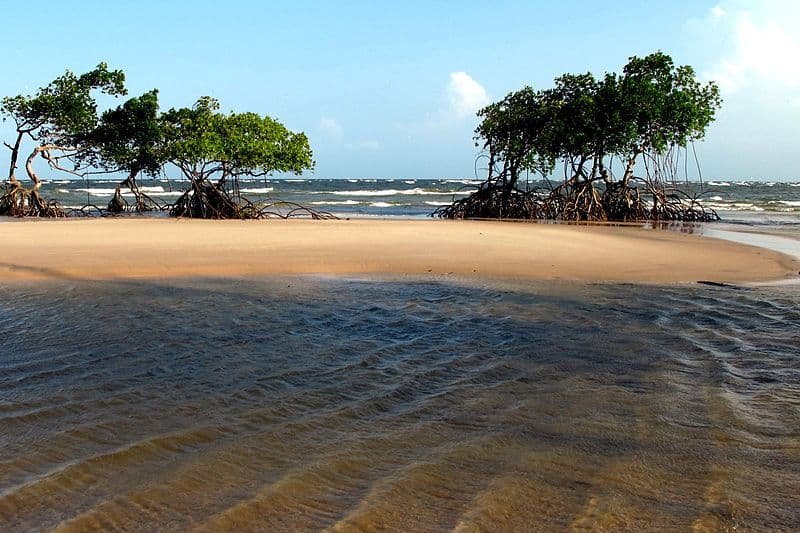
The local folklore of the north region of Brazil is very expressive in the island’s most popular districts, Soure, and Salvaterra.; with both of them holding every year in July, traditional celebratory parties.
Bragança
Located a little bit further from Belém do Pará (210km – 130 miles), Bragança is a feast to the eyes. With century-old building and manors such as Forte do Caeté, the city is also a preservation area for over 40 thousands species of birds like the guará, the maçarico and herons.
The place is also a very strong choice if you want to enjoy the nature but still having a little insfrastructe. The Campo do Meio and Farol beaches are beautiful and are supported by several local bars and even nightclubs.
Salinópolis
If you go to the north of Belém, you’ll find Salinópolis, which is located 138 miles (222km) away from the capital of Pará. The beaches in Salinópolis (especially the Atalaia beach) are the background for most major surfing events in the country, given the 6,5 feet tidal waves that are seen at the coast.
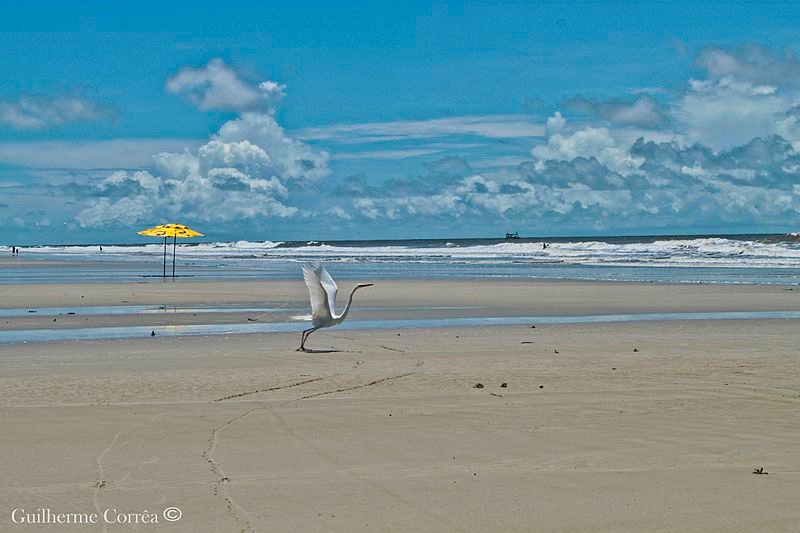
If you’re a fan of radical sports, you can also go sandboarding in Salinópolis, as well as rent a buggy car to explore the sand dunes. And if you’re the real adventurous type, you can even take an ultralight aircraft stroll to see the whole place from the sky.
In Sum, Is Belém in Brazil Worth Visiting?
Most definitely, yes! Not only Belém, but most of the north region of Brazil is unbelievably beautiful and with a few off-the-beaten places you’ll definitely fall in love with. We have featured a few of these places (and others from all regions in Brazil) in this post, so make sure to read if you want a few suggestions.
Well, that was it for our guide in Belém, Brazil! Hope we were able to show you enough ideas to make you come meet Belém and the whole north area of Brazil!
While you’re here, I think we might interest you with these:
Is it possible to travel to Brazil for free? – no abusive plane ticket rates and no need to spend fortunes on accommodations? Is it really possible to travel to Brazil without spending anything? Click to find out!
South Brazil Itinerary: travel through the REAL South – from the heated lands of the north to the cold weather of the south: find out here what you can do in the coldest region of Brazil!
One Way Tickets: Am I Allowed In Brazil Without A Return Date? – no idea when you are planning on leaving Brazil? Find out if it’s possible to go to Brazil with just a one-way ticket!
Related Questions
What is Belém like for travelers who love the beach?
Generally speaking, the north region of Brazil is a paradise for beach lovers, as there are many breathtaking coasts in the area. As part of that group, Belém does not disappoint when it comes to beautiful beaches, having Praia do Amor, Praia de Belo Paraíso, and Praia do Cruzeiro as a few examples.
Is Belém do Pará (Brazil) dangerous?
No, Belém do Pará in Brazil is not dangerous to visit. The city is generally safe and friendly during daytime, but the same as many other Brazilian cities, there’s still a lot of poverty in Belém, which can occasionally lead to petty crimes. With tthat said, if you take all the touristic safety advice in consideration (no flashy outfits or jewelry for example), you should be OK.
Cover Photo: sunset as seen from the Estação das Docas in Belém, Brazil – Credit: Flickr | Arnoldo Riker
